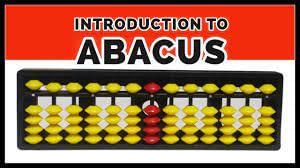Introduction to Abacus | Abacus - Class 1 PDF Download
| Table of contents |

|
| Introduction |

|
| What is Abacus? |

|
| The History of Abacus |

|
| Use of Abacus |

|
Introduction

Have you ever pondered how people coped in the absence of essential devices like calculators in centuries past?
What if I were to inform you that they possessed a calculator all along?
Indeed, it was the abacus that found extensive use for intricate calculations prior to the advent of electronic calculators.
The abacus serves as a valuable educational tool for individuals with visual impairments, as well as anyone interested in exploring the origins of modern calculators.
Merely by shifting the beads from left to right, you can perform addition operations reaching into the billions and beyond.
The abacus functions as a versatile instrument capable of performing calculations involving addition, subtraction, multiplication, and division, among other arithmetic operations. Moreover, it stimulates brain activity.
What is Abacus?
- An abacus is an instrument used for calculation or counting, featuring sliding counters on rods. It is considered the world's first calculator and was initially used in Europe, China, and Russia.
- The early version of the abacus was a shallow tray filled with sand, allowing numbers to be easily erased. Modern abaci can be made of wood or plastic and resemble a rectangular box with nine vertical rods strung with beads. These abaci are constructed from various types of hardwoods and come in different sizes.
- The frame includes vertical rods on which several wooden beads can slide freely. A horizontal beam divides the frame into two sections: the upper deck and the lower deck. Each rod holds beads that can be moved up and down using the index and thumb fingers.
The History of Abacus
- The Sumerians, around 2700 B.C., devised a fictionalized calculation tool, which consisted of a large block made of wood or clay divided into columns.
- These columns corresponded to the positional values in their base-60 numeration system, similar to how we organize numbers by units, tens, hundreds, etc.
- This early version resembled what we now recognize as an abacus. Over time, the Sumerians abandoned physical objects and began performing calculations directly on a board, allowing them to easily erase or modify their calculations.
- The Zapotecs of Central America and the Greeks developed similar devices in the 5th century B.C.
- The first Greek abacus was a table filled with sand and had a raised edge. Columns were created by running a finger through the sand-filled area.
- The term "abacus" is believed to derive from the Greek word "abax," meaning tray, table, or tablet, which, in turn, originated from the Semitic word "ABQ," signifying dust or sand.
- The initial Roman abacus was a small, flat piece of wood or bone covered in wax.
- Calculations on the Roman abacus were made by creating marks with a pointed iron instrument on one end and erasing them with the other. It was akin to the first portable calculator.
- The Romans developed more sophisticated versions of the grooved abacus, replacing the grooves with counters or beads set in wax-filled indentations on the wood.
- The Roman abacus resembled the traditional Chinese abacus, and it is believed that the Roman abacus was introduced to China at some point.
- History of Abacus: Chinese Abacus, Japanese Abacus, Russian Abacus.

- The soroban, an abacus developed in Japan, is derived from the ancient Chinese suanpan and was imported to Japan in the 17th century.
- Despite the availability of practical and affordable pocket electronic calculators, the soroban is still utilized today, similar to the suanpan.
- The right side of the soroban represents the numbers 0-9, with each column representing a digit. The lower beads represent one, while the higher beads represent five.
Use of Abacus

- The abacus is used for performing addition, subtraction, division, and multiplication.
- It can also be used to find the square roots and cube roots of numbers.
- The beads on the abacus are manipulated using the index finger or thumb of one hand.
- Using the abacus helps alleviate students' fear of mathematics by simplifying calculations.
- It nurtures and develops the natural potential of children.
- The abacus helps children develop key skills such as listening, speed, concentration, accuracy, imagination, creativity, innovation, and photographic memory.
- It is also beneficial for students with dyslexia, improving their numerical skills through tactile learning.
- Research shows that the left hemisphere of the brain, known as the digital brain, handles analytical tasks, reading, writing, and calculation, while the right hemisphere, known as the analogue brain, controls three-dimensional senses and creativity. Regular practice with the abacus helps develop the right hemisphere, contributing to overall brain development.
- The abacus enhances overall academic skills, teaching students to face and tackle challenges. It boosts their confidence and improves problem-solving abilities.
- It also enhances spatial abilities, which are valuable in fields such as architecture, engineering, and science.
|
23 videos|13 docs|3 tests
|
FAQs on Introduction to Abacus - Abacus - Class 1
| 1. What is an abacus? |  |
| 2. How does an abacus work? |  |
| 3. What is the history of the abacus? |  |
| 4. Is the abacus still used today? |  |
| 5. Can learning to use an abacus improve math skills? |  |

|
Explore Courses for Class 1 exam
|

|


















